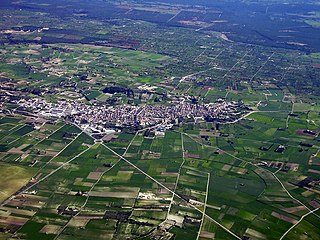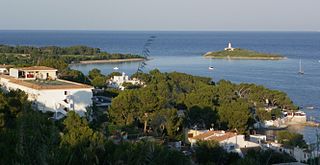
Mallorca, or Majorca, is the largest of the Balearic Islands, which are part of Spain, and the seventh largest island in the Mediterranean Sea.

Palma, also known as Palma de Mallorca, is the capital and largest city of the autonomous community of the Balearic Islands in Spain. It is situated on the south coast of Mallorca on the Bay of Palma. The Cabrera Archipelago, though widely separated from Palma proper, is administratively considered part of the municipality.

Sóller is a town and municipality near the north west coast of the Balearic Island of Mallorca, Spain, 3 km inland from Port de Sóller, in a large, bowl-shaped valley that also includes the village of Fornalutx and the hamlets of Biniaraix and Binibassi. The population is around 14,000. The Tranvía de Sóller tram links Sóller to Port de Sóller.

Manacor is a town and municipality on the island of Mallorca, part of the Spanish autonomous community of the Balearic Islands. It is the second-largest town in Mallorca, after the capital of Palma. The municipality features tourist attractions such as Porto Cristo, site of the famous Caves of Drach, and Cales de Mallorca. Manacor has one of the busiest street markets on the island, held every Monday morning. Manacor is famous for high-quality wood furniture manufacturing and artificial pearls.

Alcúdia (Catalan pronunciation:[əlˈku.ði ]) is a municipality and township of the Spanish autonomous community of the Balearic Islands. It is the main tourist centre in the North of Majorca on the eastern coast. It is a large resort popular with tourists. Most of the hotels are located in Port d'Alcúdia and Platja d'Alcúdia, along the 14 km-long (8.7 mi) beach that stretches all the way to Ca'n Picafort. In Alcúdia, the old town is well preserved with houses dating back to the 13th century. The old town is surrounded by a medieval wall.

Llucmajor is the largest municipality of the Balearic Island of Mallorca.

Banyalbufar is a municipality on the Spanish Balearic island of Majorca. The town of the same name is the administrative seat of the municipality. It borders the municipalities of Estellencs, Puigpunyent, Esporles, and Valldemossa.

Port de Pollença is a small town in northern Majorca, Spain, on the Bay of Pollença about 6 km east of Pollença and two kilometres southeast of Cala Sant Vicenç. Cap de Formentor is connected to Port de Pollença via a 13.5 km road.

Cap de Formentor is the northernmost point of Mallorca, on the Formentor peninsula.
Santa Ponsa is a small town in the southwest of Mallorca. Located in the municipality of Calvià, it is 18 kilometres from the capital Palma.

Andratx is a municipality on Mallorca, one of the Balearic Islands, along the Mediterranean east coast of Spain. It is located on the southwest tip of the island.

Artà is one of the 53 independent municipalities on the Spanish Balearic island of Majorca. The small town of the same name is the administrative seat of this municipality in the region (Comarca) of Llevant.

Santa Margalida is a municipality with a population of 10,204 located in the northeast of the Spanish Balearic Island Majorca.

The Challenge Vuelta Ciclista a Mallorca is a series of four professional one day road bicycle races held on the Spanish island of Mallorca in late January or early February. The event is used as an early season preparatory event by many of the top teams in readiness for the bigger races later in the season. The five races are ranked 1.1 on the UCI Europe Tour.
The Majorca rail network consists of three separate electrified lines, which radiate north and east from Palma de Mallorca, the major city on the Spanish island of Majorca.
A Natural Area of Special Interest is a protected area within the Balearic Islands, Spain that is below the level of a natural park.
Bocchoris was an ancient city in northern Majorca, dating back to pre-Roman times. It was one of the oldest settlements in Majorca and was once a foederatus, as recorded by Pliny the Elder.

The conquest of the island of Majorca on behalf of the Roman Catholic kingdoms was carried out by King James I of Aragon between 1229 and 1231. The pact to carry out the invasion, concluded between James I and the ecclesiastical and secular leaders, was ratified in Tarragona on 28 August 1229. It was open and promised conditions of parity for all who wished to participate.

The former ancient Muslim farmstead of Alcanada, is today known as a traditional summer holiday spot, with a beach without sand, a golf-course and a small island with a lighthouse. Alcanada, pronounced 'Aucanada' in Catalán, gave its name to the seaside area stretching from the Port d'Alcudia to the Cap de Menorca. The place name most likely came from Albecanata (Al-kaddan) – as it was known in the Llibre del Repartiment (Majorca) (1232).

S'Illot is an uninhabited islet in the Balearic Islands, Spain, located in the Mediterranean Sea off the North coast of Mallorca.


























